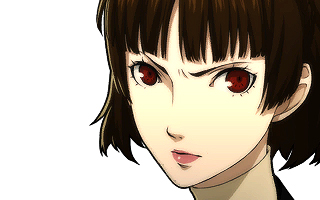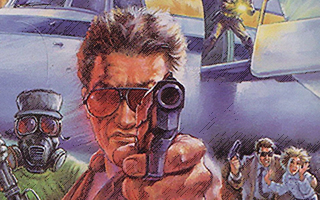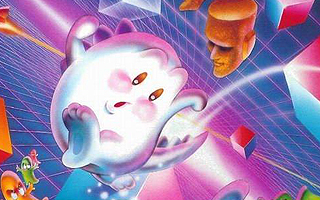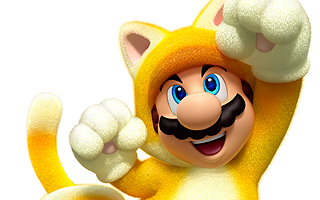Virtual Boy
Top 10 Best Nintendo Virtual Boy Games of All Time!
The Virtual Boy is a tabletop console that offered an early glimpse into virtual reality. The system housed two screens to create an illusion of depth and promised to deliver a true, stereoscopic 3D experience. Unfortunately, the design was severely flawed. The system was supposedly portable (and could run off six AA batteries), but it needed to rest on a stable surface in order to operate normally. Moreover, its sheer size made it impractical to use on the go. The portability of the system (or lack thereof) wasn’t the biggest setback. Because everyone’s eyes are different, it was necessary for the user to self-calibrate the focus and inter-pupillary distance settings in order to maintain a clear image. If these settings weren’t tuned properly, the resulting image could lead to severe eye strain. This problem was exasperated by the Virtual Boy’s monochromatic screens that displayed only black and red. The Virtual Boy caused headaches for gamers and Nintendo alike. Consumers met the system with a lukewarm reception, and Nintendo discontinued the Virtual Boy before its first birthday. Only 22 games were released for the system, with just 14 making it to North America. Plans for a European release were cancelled altogether. It didn’t have the deepest library, but most of its games weren’t available elsewhere.
10
Jack Bros.
1995

It’s kind of hard to believe that Jack Bros. even exists. It was technically the first Megami Tensei game released outside of Japan and is one of the rarest Virtual Boy games in existence. The game follows the three Jack Bros. (Jack Frost, Jack Lantern, and Jack Skelton) on their quest to return to the fairly realm from whence they came. The game employs an overhead perspective and the levels themselves are simplistic mazes. It’s kind of reminiscent to Gauntlet. The game mechanics pretty much consist of shooting enemies, collecting keys, and finding exits within the allotted time limit. It’s a pretty basic game and it probably would have been a better fit for the Game Boy. Aside from a simple scaling effect when you jump down to lower parts of the level, the game doesn’t even try to take advantage of the Virtual Boy in any way. Still, the characters are lovable and I appreciate the Halloween theme.
9
Panic Bomber
1995

Panic Bomber is a puzzle game in the style of Puyo Puyo. As falling blocks drop from the sky, it’s the players job to line up similar pieces to earn bombs. These bombs can then be used to cause chain reactions that clear out additional pieces and send useless garbage blocks to your opponent’s screen. Panic Bomber is a decent game at its core, but there were a few things holding it back. Firstly, the puzzle game genre was pretty crowded in 1995 and Panic Bomber didn’t really do anything creative. Secondly, puzzle games of this nature are always more entertaining with a second player. This wasn’t possible on the Virtual Boy, and playing against computer opponents isn’t fun. Finally, there’s no reason in the world this game needed to exist on the Virtual Boy at all. The 3D effects weren’t put to good use, so it makes little sense to put up with eye strain and headaches when superior versions of the game could be found on the Neo Geo and Super Famicom.
8
Nester’s Funky Bowling
1995

Nester’s Funky Bowling doesn’t do anything creative or unusual. There aren’t any fun bonus modes. There are no creative power-ups. The game doesn’t play around with physics. It’s just basic, fundamental bowling. Nester’s facial animations are somewhat entertaining in a “I guess it’s something” kind of way. There’s nothing outright offensive about the game, but it’s pretty unspectacular. My biggest issue is that the game probably should have been called Nester’s Bowling. There’s really nothing “funky” about the game at all – unless you count Nester’s nearly-identical twin sister, Hester. What kind of monster names their child Hester? Moreover, who would give twins rhyming names in the first place? I’m getting off track here, so I will summarize. Nester was a character who appeared in Nintendo Power comics. Bowling is bowling. This concludes your two-week course.
7
Vertical Force
1995

Vertical Force is a vertically-scrolling shooter from Hudson that allows players to change their altitudes between one of two layers. Similar mechanics had been used in earlier Hudson games like Star Soldier and Starship Hector. Most games in the genre simply task players with shooting enemies and dodging bullets, so the ability to change your altitude to avoid enemies or obstacles makes the game feel a little less formulaic than most shoot ’em ups. Unfortunately, it can be a little difficult to determine which plane something is on even though the Virtual Boy helps provide a sense of depth. I guess you can only do so much with red and black graphics. Vertical Force is a little more forgiving than most shooters, and players actually have shields. It’s nice that it doesn’t implement the usual “one hit kill” convention, but the game will still make your eyes bleed like every other game on the system.
6
V-Tetris
1995

There were two different versions of Tetris on the Virtual Boy. 3D Tetris was released exclusively in North America while V-Tetris never made it outside of Japan. 3D Tetris used a three-dimensional playing field as opposed to the traditional 2D view. Players were still required to line up falling blocks, but the wireframe graphics and slow-moving pieces made the game tedious. V-Tetris was a much more traditional title. The game introduced a cylindrical puzzle mode in which blocks could be placed in a 3D spiral, but standard Tetris gameplay modes were present as well. The game was developed by Bullet-Proof Software (who also made the Game Boy version of Tetris), but the controls are a lot more responsive in V-Tetris than they were in the original Game Boy version. The biggest fault with V-Tetris is the fact that it shouldn’t have been released in the first place. Tetris is the type of game that can be played for hours at a time, but it’s not recommended that anyone play the Virtual Boy for extended periods.
5
Galactic Pinball
1995

Galactic Pinball is a typical pinball game with an outer-space theme. In lieu of a ball, the game uses a disc that glides around the boards like an air hockey puck. The space puck is completely silent when it bounces into things, so the game doesn’t sound as obnoxious as some pinball games do. The game contains four separate boards with their own backstories, and some boards even contain multiple sets of flippers. The boards feel pretty empty compared to a lot of pinball games, but I guess this fits well with the outer-space theme. The coolest parts of the game are the bonus sections where Samus (from Metroid) shows up in her ship and the player gets to shoot down enemy ships. Galactic Pinball is pretty unspectacular and doesn’t make great use of the Virtual Boy’s hardware. Still, it’s a relatively enjoyable pinball game with a creative theme and a surprisingly awesome soundtrack.
4
Mario Clash
1995

Mario Clash is a reimagining of the original Mario Bros. from 1983. The game gives players a simple goal of defeating enemies by throwing koopa shells at them. The levels consist of background and foreground planes, and certain enemies can only be defeated if Mario throws a shell at them from an opposite plane. Mario Clash is an interesting take on a classic formula, but it doesn’t go far enough. The game could have been spectacular if it featured more enemies, creative power-ups, and two-player support. An appearance by Luigi could have made the game feel like a true successor to the original Mario Bros.. To its credit, the stages in Mario Clash are both creative and numerous. There are a staggering 99 stages to play through, in fact. Sadly, the game has no way of saving the player’s progress or high scores. The Virtual Boy doesn’t lend itself well to long play sessions, so the lack of a save system was especially unfortunate.
3
Mario’s Tennis
1995

There’s not a lot that needs to be said about Mario’s Tennis. Later entries in the Mario Tennis series added power shots, special items, and gimmick courts that were populated by various enemy characters. Mario’s Tennis, in contrast, is basically just regular tennis with Mario characters thrown in for good measure. The game is played from a third-person perspective, but the camera is positioned directly behind the player to accentuate the depth of the court. The Virtual Boy’s 3D effects are more important in Mario’s Tennis than in any other game, as they make it possible to determine where your character is in relation to the ball. The same game without 3D effects would be an exercise in frustration. Mario’s Tennis was one of four launch games for the Virtual Boy and was chosen as the console’s pack-in game in North America. The game does a decent job of showcasing the system, but it’s light on content. There are only seven characters to choose from and no multiplayer options to speak of. Two-player support for the game was announced, but it was never implemented since the Virtual Boy link cable was never released.
2
Teleroboxer
1995

Teleroboxer is a boxing sim with a “Rock ‘Em Sock ‘Em Robots” vibe. The game could best be described as Punch-Out!! with 22nd century robots instead of 1980s racial stereotypes. The game is played from a first-person perspective, so the 3D effects are surprisingly effective. As your opponents try to punch you in the face, it actually feels like they are trying to punch you in the face! The game is also one of the few Virtual Boy games to make use of both directional pads. The ability to block with one arm while punching with the other adds a level of complexity not seen in most boxing games. (Nintendo probably had games like this in mind when they designed the Virtual Boy’s controller.) The characters in the game are well-animated and surprisingly detailed, and it’s not too much of a stretch to call Teleroboxer the best-looking game on the system. With only nine robot opponents to square off against, the game is fairly light on content. There’s a steep learning curve and the difficulty ramps up in the later stages, however, so it will likely take a while to master. Teleroboxer was the second game produced by Nintendo’s Team Deer Force; the first being Super Metroid. Teleroboxer obviously didn’t receive the acclaim that Super Metroid did, but it was still the perfect game to showcase the Virtual Boy.
1
Virtual Boy Wario Land
1995

Virtual Boy Wario Land is a direct follow-up to Wario Land: Super Mario Land 3. The basic premise is essentially the same, and Wario is once again on a hunt to find treasure. In order to do this, Wario will make use of several hats that grant him special abilities. The Dragon Hat allows Wario to use a flamethrower, the Bull Helmet makes him more powerful, and the Eagle Hat gives him the power of flight. The concept and power-up systems are basically unchanged from it’s Game Boy predecessor, but Virtual Boy Wario Land made it possible for players to jump into the background at certain points. This is done to reach new areas or to evade attacks during boss battles. Other games have used similar multi-plane gimmicks, but the Virtual Boy is really effective in creating a sense of depth. Nintendo’s ill-fated system was home to a handful of interesting titles, but no other game was even considered for the number one position. Virtual Boy Wario Land is the only legitimately great game on the system, and it’s almost reason enough to own a Virtual Boy by itself.





Do you agree with this list? Let us know what you think by leaving a comment below. Your opinion matters!